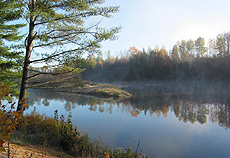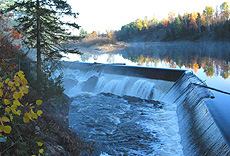 Without a doubt, one of the premier heritage sites in the Pontiac is Chutes Coulonge Park. Located a few miles north of Fort Coulonge, this park is important not only in terms of the natural splendour of the Coulonge River, with its spectacular waterfalls and canyon, but in terms of the site’s historic significance, as well.
Without a doubt, one of the premier heritage sites in the Pontiac is Chutes Coulonge Park. Located a few miles north of Fort Coulonge, this park is important not only in terms of the natural splendour of the Coulonge River, with its spectacular waterfalls and canyon, but in terms of the site’s historic significance, as well.
SQUARED TIMBER AND LOG DRIVES
The history of the Coulonge Falls is closely associated with the great era of squared timber and log drives.
In the 1840s, lumber baron George Bryson bought up much of the timber rights along the banks of the Coulonge River, including the area in the immediate vicinity of the falls. Then, as now, the area was rich in pine. The massive pine logs, which were cut on site into 60-foot (18-metre) lengths, were transported to market by driving them downstream to the Ottawa River.
LOG SLIDE
The Coulonge Falls – actually a series of three waterfalls – tumble 157 feet (48 metres). At their base is the start of a 3,000-foot (914-metre) canyon. The falls themselves represented a major obstacle for Bryson. Logs that were sent directly over the falls could easily be damaged or broken in the process – far too risky for such a valuable commodity.
Bryson’s solution was to bypass the falls and canyon with a log slide, which he constructed entirely of wood, and which extended the entire length of the river from the top of the first falls to the bottom of the canyon. On the opposite bank of the river, near the crest of the first falls, Bryson built a cabin for a slide master. The slide master would oversee the operation of the timber slide. In time, the falls would be the centre of an extensive lumber operation, with sawmills and many men employed in felling, cutting, processing, and driving the timber down river.
PATHS
Today, access to Coulonge Falls Park is by a winding back road which emerges near the banks of the Coulonge River, not far above the falls. At the reception area, visitors pay a modest entry fee ($5.00 for adults, free for children under 12). An informative, bilingual guidebook is available. It includes a map of the park – with the paths and sites to be seen along the way – and lots of fascinating history on George Bryson, the timber industry, and the methods employed by the log drivers.
PANELS
Visitors should plan for about 1 ½ hours at the park, but many people choose to stay longer, admiring the views or taking pictures. There are also facilities for a picnic, and numerous spots to sit and relax. Especially interesting are the bilingual, interpretive panels that are placed at strategic locations throughout the park. They provide fascinating background on subjects such as the slide master’s cabin, river camps, log drives, the pine forest, the geology of the falls, and more.
Visitors will find the park both fascinating and breathtaking. From the reception area, a path leads down to the river, where it joins up with a bridge. Here, one is treated to a close-up view of the first waterfall and dam. Across the bridge is an island, the site of Bryson’s original sawmill. Remnants of early machinery are visible near the path. From a lookout on this island, the slide master’s cabin is still visible on the opposite side of the bank. A second bridge leads to another small island, virtually a rock outcrop, from which the top of a 300-foot (91-metre) modern log slide is visible. Bryson’s original wooden slide extended all the way from here to the far end of the canyon, some 3,000 feet (914 metres) down river.
THE GRANDE CHUTE
Visitors retrace their steps back across the two bridges and continue downstream to another lookout. From here the main waterfall, the Grande Chute, is visible. The view is spectacular. To the right is the foot of the modern log slide.
Downstream is another lookout. From here the Coulonge River canyon is visible. A little further down the path is one last lookout, with a view of the third and final waterfall. The path returns from here to the reception area. Facilities at the reception include: a display of artifacts related to the logging era; a video of the last log drive on the Coulonge River; a souvenir shop; a snack bar; and washrooms. Chutes Coulonge Park is open from May through October.
For more information on Chutes Coulonge Park, contact: Chutes Coulonge, 100 Promenade du Parc-des-Chutes,Mansfield, QC J0X 1V0. Tel.: (819) 683-2770 or toll free 1 (888) 683-2770. Fax: (819) 683-2770. Email: [email protected]Or visit the park website at: www.chutescoulonge.qc.ca.

